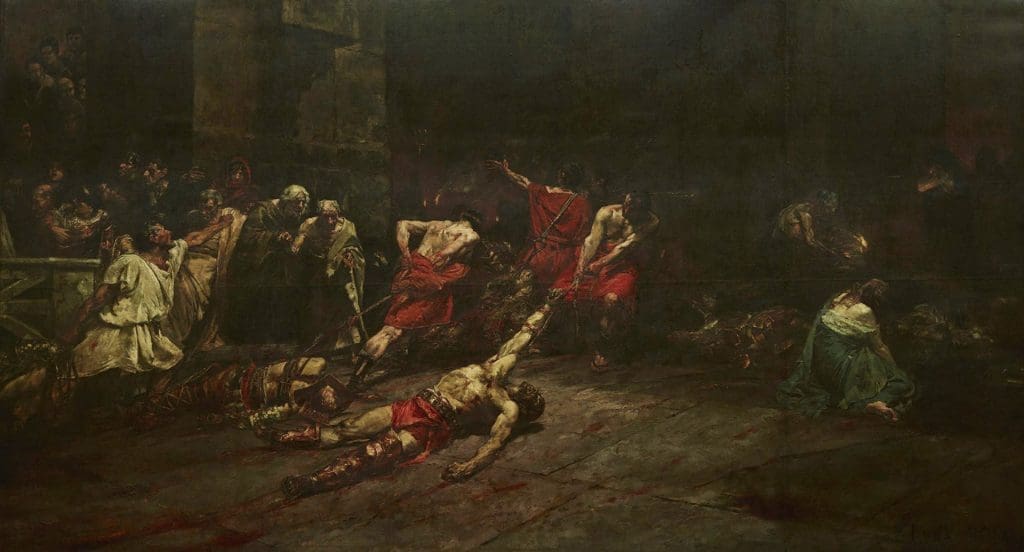The Philippines is known to be a melting pot of beauty. More than its scenic views, the country also boasts its rich culture — making it an appealing choice for travelers seeking all kinds of adventure.

Whether it is exploring the mountains, conquering waves, or celebrating lively fiestas, the Philippines never seems to run out of options.
This includes places where you can take a peek at its tragic yet captivating history through the artworks that reflect it.
Want to dive deep into the Philippines’ art scene? Here are ten of the most famous Filipino paintings and where you can visit them:
1. Spoliarium

Considered the largest painting in the Philippines, “Spoliarium” is among the notable art pieces of Filipino painter Juan Luna. It features the bloody gladiator matches of Romans but is also an allegory to the despair and abuses Filipinos suffered from during the Spanish reign in the country.
The artwork currently stands tall at the center of the main gallery of the National Museum of Fine Arts at 4.22 meters x 7.675 meters in dimensions.
Where to see it: National Museum of Fine Arts (Manila, Philippines)
Entrance fee: Free
2. Planting Rice

An artist known for his distinctive art style and realistic paintings, Filipino painter Fernando Amorsolo is best known for his depiction of the country’s culture, its picturesque sceneries, portraits of women, and scenes from World War II.
One of his most popular paintings is “Planting Rice”, where he depicted a group of farmers — both men and women — toiling under the sun.
Like “Spoliarium”, it can also be visited at the National Museum of Fine Arts in Manila along with his other pieces.
Where to see it: National Museum of Fine Arts (Manila)
Entrance fee: Free
3. Sabel

The Philippine art scene would not be complete without the mention of National Artist Benedicto Cabrera. His artworks are currently on display inside his museum in Baguio City including his famous painting “Sabel”.
Cabrera previously said “Sabel” is a homeless Filipino woman whom he photographed and first sketched in 1965. Her disposition became a symbol of dislocation, despair, and isolation for the painter — making her a recurring subject in his figurative paintings.
Where to see it: BenCab Museum (Baguio City)
Entrance fee:
- Regular Fee: PHP 150
- Students: PHP 120
- Senior Citizens/ PWDs: PHP 100
4. Madonna of the Slums

A key modernist painting in the 1950s, Vicente Manansala’s “Madonna of the Slums” pictures a mother and child who are said to become shanties in the city after leaving their provincial life.
Many interpretations of the artwork have been made but a notable one said it reflects the anxiety and insecurity of Filipinos post-war.
Where to see it: National Museum of Fine Arts (Manila)
Entrance fee: Free
5. The Parisian Life

Also known as Interior d’un Cafi (or Inside a Café), the impressionist painting is another masterpiece of Juan Luna. Unlike his earlier works, the “Parisian Life” shy away from his usual intense and dramatic subjects and instead portrayed a “fleeting moment of ordinary life” during his stay in Paris in the 1890s.
Featured at the center of the artwork is a young woman sitting uncomfortably on a sofa while behind her are three Filipino patriots who would eventually change the country’s history — Luna himself, Jose Rizal, and Ariston Bautista Lin.
Where to see it: National Museum of Fine Arts (Manila)
Entrance fee: Free
6. The Happiest Place on Earth

Another Filipino gem is contemporary painter Elmer Borlongan. Having been born in the urban, Borlongan strived to depict the everyday life in the city.
His famous work “The Happiest Place on Earth”, is currently stored in Pinto Art Museum in Antipolo City, Rizal.
Where to see it: Pinto Art Museum (Antipolo, Rizal)
Entrance fee: P250
7. Yellow Confetti

The rise of the people and fall of the dictatorship through the 1986 EDSA People Power Revolution are among the major events that changed the course of Philippine history.
Amid the chaos was Benedicto Cabrera, who encapsulated the civil resistance of Filipinos at the time through his controversial art piece “Yellow Confetti”.
Where to see it: BenCab Museum (Baguio City)
Entrance fee:
- Regular Fee: PHP 150
- Students: PHP 120
- Senior Citizens/ PWDs: PHP 100
8. First Mass at Limasawa

An interpretation of the first documented Christian mass in the Philippines in 1521, “First Mass at Limasawa” is one of Carlos Modesto “Botong” Villaluz Francisco’s most important paintings.
The national government commissioned Francisco to create the artwork for the commemoration of 400 years of Philippine Christianization.
Where to see it: National Museum of Fine Arts (Manila)
Entrance fee: Free
9. Three Women with Baskets

The only female member of “13 moderns”, Anita Magsaysay-Ho’s artworks show her high regard for women in Filipino culture. This is true in all of her paintings including “Three Women with Baskets” where she pictured female basket weavers enamored with their daily lives.
Other members of “13 moderns” are: Botong Francisco, Galo Ocampo, Lorenzo, Vicente Manansala, HR Ocampo, Anita Magasaysay-Ho, Cesar Legaspi, Demetrio Diego, Ricarte Purugganan, Jose Pardo, Bonifacio Cristobal and Arsenio Capili
Where to see it: Yuchengco Museum (Makati City)
Entrance fee:
- Regular Fee: PHP 100
- Students/Senior Citizens/ PWDs: PHP 50
10. Hills of Nikko

No Filipino artist does abstract painting like National Artist for Visual Arts Jose Joya. With his masterful technique called “gestural painting” or “action painting,” he
While it is his interpretation of the hills in Nikko, Japan, critics say Joya’s painting is an allegory of human imperfections.
Where to see it: National Museum of Fine Arts (Manila)
Entrance fee: Free
